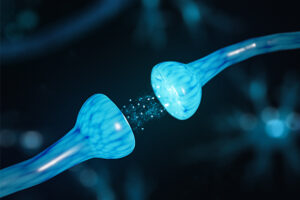Psychiatry
Tardive Dyskinesia
Central Dopamine Blockade in the Pathophysiology of Tardive Dyskinesia
Overview
Dopamine receptor–blocking agents (DRBAs) are thought to lead to the development of tardive dyskinesia (TD) through mechanisms that involve postsynaptic dopamine receptor upregulation or “supersensitivity.” Additional aspects of the pathophysiology, such as the role of genetic predisposition, continue to be explored.
How would you describe the current understanding of the pathophysiology of TD?
Andrew J. Cutler, MD
|
|
“The leading theory on the pathophysiology of TD is that chronic DRBA treatment causes the supersensitivity of dopamine receptors in the dorsal striatum, which means that more dopamine receptors are made and/or the ones that are made become more sensitive to dopamine.”
The leading theory on the pathophysiology of TD is that chronic DRBA treatment causes the supersensitivity of dopamine receptors in the dorsal striatum, which means that more dopamine receptors are made and/or the ones that are made become more sensitive to dopamine. Thus, neurons in the brain are essentially trying to compensate and circumvent the dopamine blockade. This creates a critical imbalance in the direct and indirect dopamine pathways that coordinate movement.
Supporting the supersensitivity theory is that vesicular monoamine transporter 2 (VMAT2) inhibitors, which decrease dopamine release, are effective in balancing or reregulating the dopamine system. Also supporting the supersensitivity theory is that increasing the dose of an antipsychotic medication in a person with TD can produce a partial suppression of the dyskinetic movements. However, while DRBAs are thought to upregulate the postsynaptic D2 receptors in all patients, not all patients develop TD. Additionally, if the DRBA is stopped and the dopamine receptors revert back to the way they were before treatment, this does not always lead to resolution of the TD, which suggests the presence of additional mechanisms in the pathophysiology of TD.
Researchers have begun investigating beyond the supersensitization theory, and it is possible that supersensitization is just the first step in a cascade of events in some individuals. Chronic DRBA treatment may contribute to oxidative stress caused by other mechanisms, and it is possible that damage to interneurons may be involved. There may also be maladaptive synaptic plasticity, which refers to the connections between neurons. The more connections—the more synapses—the better. TD may involve a reduction in those synapses or damage to them, resulting in the neurons not being able to communicate properly. Finally, it has always been fascinating to me that most patients who are treated with antipsychotics do not develop TD, which suggests that genetic susceptibilities may be involved.
Leslie Citrome, MD, MPH
|
|
“DRBAs such as antipsychotics block dopamine D2 receptors in the ventral striatum, reducing hallucinations and delusions, but the 'collateral damage' is that DRBAs also block D2 receptors in the dorsal striatum, which can deleteriously affect motor control.”
Over the years, various insights into the pathophysiology of TD have driven different treatment approaches. For example, the idea that oxidative stress leads to abnormalities in brain circuitry led to the idea that antioxidants might be helpful. That has been an avenue of investigation for many years, and it has not demonstrated consistent success in the treatment of TD. Abnormalities in cholinergic circuitry have also been implicated, which may explain why the exposure to benztropine may increase the risk of TD. GABAergic and other mechanisms have also been proposed, which led to the use of treatments such as clonazepam.
Currently, the primary theory explaining TD is dopamine receptor upregulation or “supersensitivity,” particularly in the dorsal striatum, the part of the striatum that plays an important role in motor control. DRBAs such as antipsychotics block dopamine D2 receptors in the ventral striatum, reducing hallucinations and delusions, but the "collateral damage” is that DRBAs also block D2 receptors in the dorsal striatum, which can deleteriously affect motor control. It does not take much aberrant signaling or excess dopamine to generate a dyskinetic movement.
As noted previously, this theory explains why a VMAT2 inhibitor, which decreases the amount of dopamine that is released, can be used to treat TD. It also explains why TD movements can be masked, at least temporarily, by increasing the dose of the antipsychotic that is being given and blocking more dopamine receptors. If you decrease the dose of the antipsychotic, the blockade of dopamine receptors is reduced, and you may see more TD. These clinical observations support the dopamine supersensitivity hypothesis.
Rakesh Jain, MD, MPH
|
|
“There is general agreement among experts on the fundamentals of TD etiology and pathophysiology. That is, D2 receptor blockade is a necessary precursor for the development of TD, and, quite likely, GABA/glutamate imbalance is also involved in its pathophysiology.”
Existing theories about the pathophysiology of TD include the D2 hypersensitivity model and the imbalance between the direct and indirect pathways in the striatum that control and modulate voluntary movement modulation. While we do not have a single cohesive model that explains every aspect of TD, it seems clear that each of the 2 primary hypotheses (ie, dopamine supersensitivity and direct and indirect pathway imbalance with GABA/glutamate imbalance) may be central mechanistic features in patients with TD.
There is general agreement among experts on the fundamentals of TD etiology and pathophysiology. That is, D2 receptor blockade is a necessary precursor for the development of TD, and, quite likely, GABA/glutamate imbalance is also involved in its pathophysiology.
The success of VMAT2 inhibitors in reducing the symptoms of TD highlights that elements of our theoretical understanding of the pathophysiology of TD are aligned with the clinical reality. We now have effective treatments for TD, whereas, until very recently, our tools to treat TD were quite limited. If a patient has tried just 1 of the 2 US Food and Drug Administration–approved VMAT2 inhibitors with limited success, it will be crucial to try the other one. The 2 VMAT2s that are approved are pharmacokinetically and pharmacodynamically different enough that one should not consider TD to be refractory unless both have been tried at the optimum dose for the optimum length of time.
References
Caroff SN. Recent advances in the pharmacology of tardive dyskinesia. Clin Psychopharmacol Neurosci. 2020;18(4):493-506. doi:10.9758/cpn.2020.18.4.493
Conti MM, Chambers N, Bishop C. A new outlook on cholinergic interneurons in Parkinson’s disease and L-DOPA-induced dyskinesia. Neurosci Biobehav Rev. 2018;92:67-82. doi:10.1016/j.neubiorev.2018.05.021
Margolese HC, Chouinard G, Kolivakis TT, Beauclair L, Miller R. Tardive dyskinesia in the era of typical and atypical antipsychotics. Part 1: pathophysiology and mechanisms of induction. Can J Psychiatry. 2005;50(9):541-547. doi:10.1177/070674370505000907
Miller R, Chouinard G. Loss of striatal cholinergic neurons as a basis for tardive and L-dopa-induced dyskinesias, neuroleptic-induced supersensitivity psychosis and refractory schizophrenia. Biol Psychiatry. 1993;34(10):713-738. doi:10.1016/0006-3223(93)90044-e
Teo JT, Edwards MJ, Bhatia K. Tardive dyskinesia is caused by maladaptive synaptic plasticity: a hypothesis. Mov Disord. 2012;27(10):1205-1215. doi:10.1002/mds.25107
Ward KM, Citrome L. Antipsychotic-related movement disorders: drug-induced parkinsonism vs. tardive dyskinesia—key differences in pathophysiology and clinical management. Neurol Ther. 2018;7(2):233-248. doi:10.1007/s40120-018-0105-0













